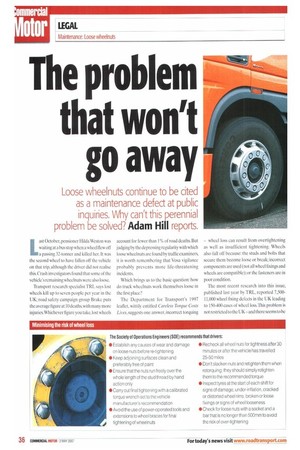The Society of Operations Engineers (SUE) recommends that drivers:
Page 36

If you've noticed an error in this article please click here to report it so we can fix it.
• Establish any causes of wear and damage on loose nuts before re-tightening • Keep adjoining surfaces clean and preferably free of paint • Ensure that the nuts run freely over the whole length of the stud thread by hand action only
• Carry out final tightening with a calibrated torque wrench set to the vehicle manufacturer's recommendation
• Avoid the use of power-operated tools and extensions to wheel braces for final tightening of wheelnuts
9 Recheck all wheel nuts for tightness after 30 minutes or after the vehicle has travelled 25-50 miles
• Don't slacken nuts and retighten them when retorquing; they should simply retighten them to the recommended torque
• Inspect tyres at the start of each shift for signs of damage, under-inflation, cracked or distorted wheel rims, broken or loose fixings or signs of wheel looseness
• Check for loose nuts with a socket and a bar that is no longer than 500mm to avoid the risk of aver-tightening


























































































































































































